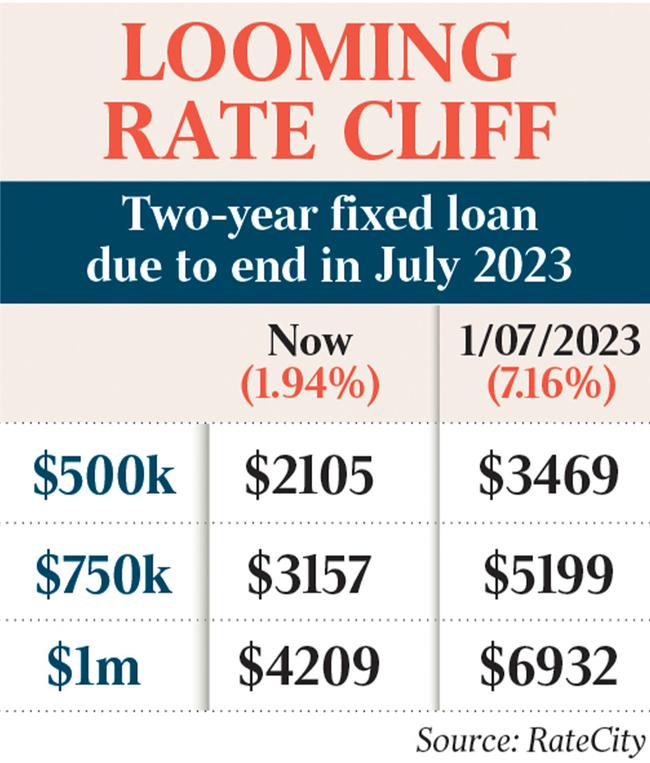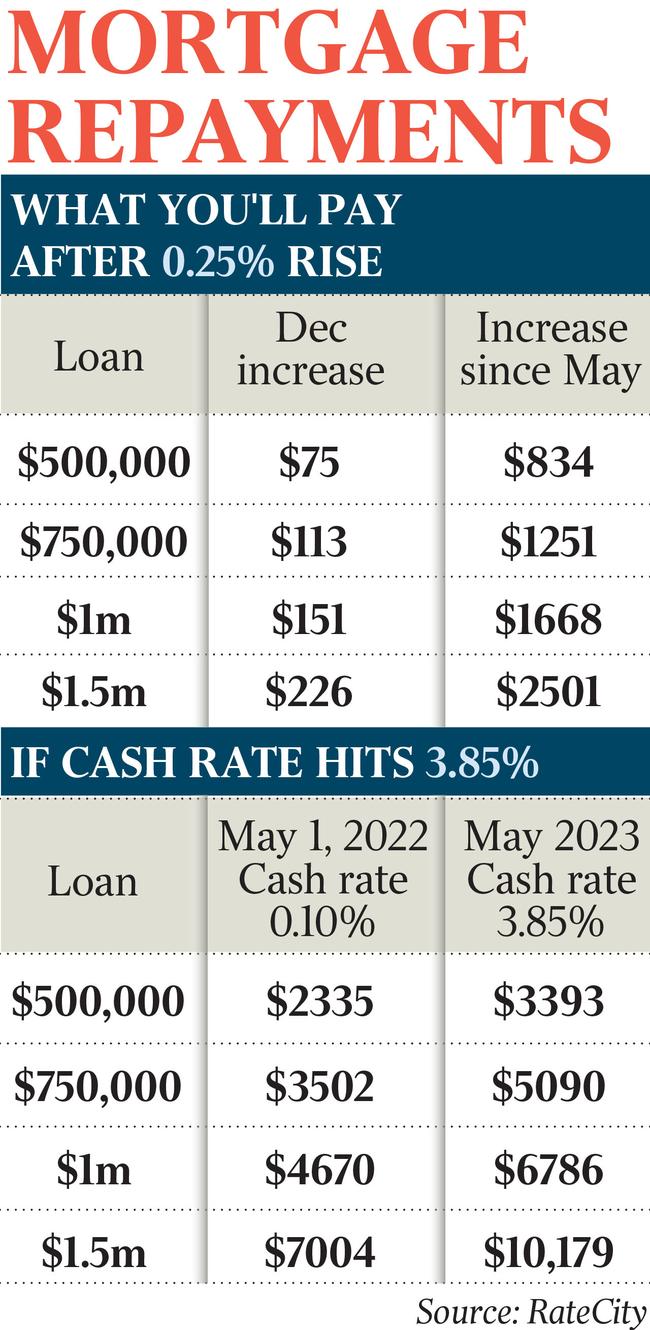Payments pain looms as super-low fixed interest rates end
An estimated $370bn in mortgages will come off fixed rates next year, threatening to blow out families’ interest payments by up to 65 per cent.

An estimated $370bn in mortgages will come off fixed rates in 2023, a ticking debt bomb that threatens to blow out families’ interest payments by as much as 65 per cent and put a hole in economic growth.
Millions of Australians locked in to ultra-low rates are yet to feel the sting of this year’s rapid rise in borrowing costs, with the Reserve Bank board on Tuesday delivering the eighth straight rate hike, bringing the key cash rate to 3.1 per cent.
With leading economists predicting as many as three further rate rises next year, the nearly half of all new loans fixed in mid-2021 at below 2 per cent are set to roll off to rates as high as 7.2 per cent, according to RateCity estimates.

A homeowner who borrowed $750,000 and fixed for two years at 1.94 per cent – the average offer among the big four lenders roughly 18 months ago – will be paying $2000, or 65 per cent, more and see their monthly repayments jump to $5200 when their fixed loan automatically reverts to a variable rate which could be as high as 7.18 per cent.
Renegotiating to a better 6 per cent rate would still see the repayment jump by more than $1500 a month – or 50 per cent – to $4700, the RateCity analysis shows.
Record low rates, fear of missing out amid surging property prices, and guidance from the Reserve Bank that rates would stay low for years led many borrowers to extend themselves with larger loans and higher repayment burdens during the pandemic.
Many fixed-rate borrowers have enjoyed a honeymoon period immune to this year’s rate hikes, but the mass roll-off of these loans in 2023 is now a major threat to household finances, spending and growth.
Jim Chalmers said the latest rate hike would be “very difficult news” for many homeowners.
“This is the Christmas present that no Australian homeowner wanted,” the Treasurer told Sky News. “I think we are seeing the beginnings of the economic impact of these rate rises.

“Australians with a mortgage and particularly those with a big mortgage are already feeling the impacts of these rate rises since before the election. But the economic impact is still to play out, still ahead of us.”
Barrenjoey chief economist Jo Masters said the wave of maturing fixed mortgages would gather pace from April, when $35bn of loans would reset. The monthly peak would be $44bn in May, but the pace of maturing fixed-rate loans would remain high at about $30-40bn over the balance of next year, bringing the total to $370bn in 2023.
As the waves of maturing mortgages snap households into suddenly much higher interest payments, Ms Masters said she expected the effect would be a contraction in per capita consumption for four consecutive quarters from March of next year.
Population growth would keep the economy expanding overall, but the spending recession would drag real GDP growth down to just 1 per cent in 2023. “Unquestionably, a lot of Australian households are going to feel a reduction in free cash flow for discretionary spending,” she said. “It’s clearly one of the key things they (the RBA) are watching, as there’s a lot of uncertainty around it.

“I think the RBA will go again (raise rates) in February and March and then pause. And one of the reasons to pause is because you want to see how all this plays out, and then towards the end of the year, if the economy is weakening faster than expected, then you can cut rates. And if they get to the end of the year and inflation is proving more persistent, then they can hike again.”
Ms Masters said there was little visibility on how much households on low fixed rates had put aside as a buffer against the future re-set to a higher rate.
“I imagine the savings are not that big, but you would think some of those borrowers have been putting a bit aside in a traditional savings account, and which could be some of that additional $260bn cash put in bank accounts since the start of the pandemic,” she said.
Ms Masters said low unemployment and a tight labour market offered ample opportunity to pick up additional work and income where needed, and that job security would be the key difference between a material slowdown in growth and a “really scarring recession”.
Australians during the pandemic jumped to lock in the cheapest lending rates in history, as the Reserve Bank slashed its cash rate target to a record low of 0.1 per cent.
Believing rates would not need to rise until 2024, the RBA also pinned borrowing rates out to three years at the same level, allowing banks to pass on virtually free money to their customers in the form of fixed mortgages at below 2 per cent.
By the middle of 2021, nearly half of all new mortgages by value were being extended on a fixed rate, predominantly with a maturity of two years.
That was almost double the previous peak of 25 per cent leading into the GFC, when potential buyers rushed to fixed rates on the (mistaken) prediction that rates were set to soar over the months ahead.
Last year, an unprecedented 35 per cent of the total stock of outstanding home loans were on fixed rates.
RateCity head of research Sally Tindall said only 4 per cent of new mortgages were now being approved on fixed rates.
“That’s not surprising, as fixed rates are not competitive right now, and opting to fix right now is a massive gamble,” Ms Tindall said.








To join the conversation, please log in. Don't have an account? Register
Join the conversation, you are commenting as Logout